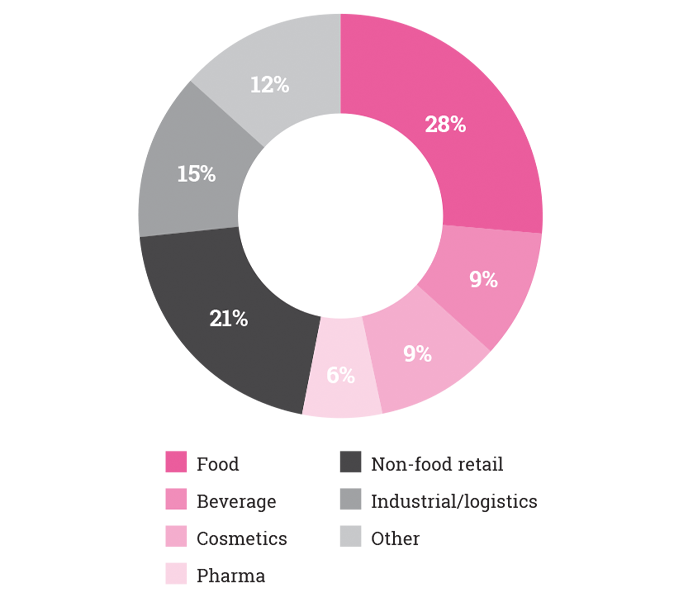A recent study from Smithers Pira (The Future of Label Printing to 2022) estimates that the label printing market worldwide will be 35.7 billion USD in 2017, and then grow at 4.4 percent year-on-year to reach 43.8 billion USD in 2022. According to Smithers Pira research, the most widely used labels are web-fed pressure-sensitive grades.
FOOD
Food labels account for almost one in three of all self-adhesive labels used worldwide. This amounts to some six billion sqm of labelstock every year, or enough to cover the whole of Texas and still have some left over. For wet glue and wraparound food labels annual consumption is estimated at between four and six billion sqm. Foods may be packed in rigid or flexible plastic packs, in cartons or in glass.
Each type of pack has its specific labeling imperatives. Temperature is also important: labels for chilled or frozen foods must withstand temperature changes without becoming wrinkled or detached.
COSMETICS, HEALTH AND BEAUTY PRODUCTS
All these products, unlike prescription drugs, are products of choice. And since the consumer can take them or leave them, the attractiveness of the label and packaging is vital if the product is to succeed.
Aside from legal regulations, labeling needs to respect both the marketing imperatives (exclusive perfumes are labeled differently from mass-market ones), and the physical ones (bathroom cosmetics must be moisture-resistant, sun creams must resist both water and strong light).
Hair coloring, eye makeup and skin care for example each have their specific labeling requirements.
BEVERAGES
The total world market for bottled beverages (both alcoholic and non-alcoholic) is estimated at one thousand billion liters, nearly all of it labeled. Quality regulations are stringent, and ingredients, degree of alcohol and storage recommendations must generally be printed on the label. Alcoholic beverages are frequently taxed, and hence frequently counterfeited. Security closures and hard-to-copy labels offer some protection. Brands are important, as are colors (the red of Coca-Cola labels must be exactly the same world-wide).
Each type of beverage has its own labeling requirements. Waters, soft drinks, wines, beers and spirits must be treated separately. In Chapter 4 of this book we look at the labeling requirements for each of these product groups.
PHARMACEUTICAL AND MEDICAL
In developed markets, and in particular the United States, the health sector is large and growing. Americans spend an estimated thirteen percent of their GDP on health-related products and services. In almost all parts of the world, regulations and directives for the labeling of medical and pharmaceutical products are very strict.
Counterfeiting is rife particularly in developing countries.
It has been estimated that one third of all the drugs sold in Africa are fakes. Many of these fakes are useless, others may be actively harmful.
With increasing concern for better protection and counterfeit protection, we can be sure that pharmaceutical label markets (currently estimated at between 1.3 and 1.5 million sqm for self-adhesives) are likely to grow even faster than the pharma market itself.
Another article on the pharmaceutical and medical sectors has information on the regulatory background for pharma labels, and explains the labeling requirements for prescription and non-prescription drugs.
It also looks at the way labels are being used in hospital environments to reduce human error and provide better security for both patients and health-care workers.
NON-FOOD RETAIL AND HOUSEHOLD DURABLE PRODUCTS
Non-food retail products include cleaning and disinfecting products (also called ‘under-the-sink’), some of which are hazardous, and all kinds of apparel and shoes. These account for the biggest volumes of labels. Also included in this category are most of the goods you will find in a hardware or do-it-yourself store, or in a sports goods retail outlet. An article on this sector suggests the optimum type of label (wraparound, wet-glue, self-adhesive, sleeve etc.) for each type of product. It also suggests solutions for labeling ‘difficult’ products like paints and varnishes.
INDUSTRIAL LABELS
Industrial labels are also a steadily growing end-user sector. These labels are technical, and are generally machine-readable. They are frequently subsumed into a track-and-trace system to provide security and traceability. This is particularly true for car and aircraft parts. Labels for identifying engine parts must adhere and be legible over long periods despite vibration, grease and dust. Tire labels are a classic example of a labelstock developed specifically to adhere to a difficult surface.
Generally, industrial labels require a substrate and adhesive adapted to the product to be labeled. This is explained and expanded on in a separate article.
Roll-to-roll printing using conductive inks could pave the way to cheaper electronic components. Although this is not strictly a label application, it is well suited to run on a narrow web press. So far, this is only at the development stage.
SPECIAL LABELS AND CONSTRUCTIONS
There are many special label innovations, with new ones appearing every day. The final chapter of this book looks at just a few of these: re-closable labels, multi-page and ‘smart’ labels are examples of how ingenious ideas have been turned into profitable products to expand the global label market while helping the end-user solve a problem.
In an article on special labels and constructions we also consider the vital question of environmental issues. Labels can and should be recycled but this is often difficult to achieve. For the question of waste liner recycling several initiatives are starting to produce results.

Figure 1.1 World pressure-sensitive label end-use segmentation by volume (sqm). Source- AWA Alexander Watson Associates
December 04, 2020 at 10:52PM
https://ift.tt/3qEgI9Q
An introduction to label markets and applications - Labels and Labeling
https://ift.tt/3fbzbE8
Bagikan Berita Ini

















0 Response to "An introduction to label markets and applications - Labels and Labeling"
Post a Comment